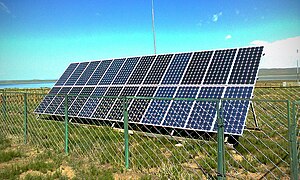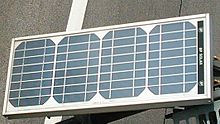Solar panel




A solar panel (also solar module, photovoltaic module or photovoltaic panel) is a packaged connected assembly of photovoltaic cells. The solar panel can be used as a component of a larger photovoltaic system to generate and supply electricity in commercial and residential applications. Each panel is rated by its DC output power under standard test conditions, and typically ranges from 100 to 320 watts. The efficiency of a panel determines the area of a panel given the same rated output - an 8% efficient 230 watt panel will have twice the area of a 16% efficient 230 watt panel. Because a single solar panel can produce only a limited amount of power, most installations contain multiple panels. A photovoltaic system typically includes an array of solar panels, an inverter, and sometimes a battery and or solar tracker and interconnection wiring.
Theory and construction

Solar panels use light energy (photons) from the sun to generate electricity through the photovoltaic effect. The structural (load carrying) member of a module can either be the top layer or the back layer. The majority of modules use wafer-based crystalline silicon cells or thin-film cells based on cadmium telluride or silicon. The conducting wires that take the current off the panels may contain silver, copper or other non-magnetic conductive transition metals.
The cells must be connected electrically to one another and to the rest of the system. Popular photovoltaic panels, in terrestrial applications typically use MC3 (older) or MC4 connectors to facilitate easy weatherproof connections. Cells must also be protected from mechanical damage and moisture. Most solar panels are rigid, but semi-flexible ones are available, based on thin-film cells.
Electrical connections are made in series to achieve a desired output voltage and/or in parallel to provide a desired current capability.
Separate bypass diodes may be used, in case of partial panel shading, to maximize the output of panel sections still illuminated. The p-n junctions of mono-crystalline silicon cells may have adequate reverse current characteristics to prevent any reverse panel section curent. Reverse currents could lead to overheating of shaded cells. Solar cells become less efficient at higher temperatures and installers try to provide good ventilation behind solar panels.[1]
Some recent solar panel designs include concentrators in which light is focused by lenses or mirrors onto an array of smaller cells. This enables the use of cells with a high cost per unit area (such as gallium arsenide) in a cost-effective way.[citation needed]
Depending on construction, photovoltaic panels can produce electricity from a range of frequencies of light, but usually cannot cover the entire solar range (specifically, ultraviolet, infrared and low or diffused light). Hence much of the incident sunlight energy is wasted by solar panels, and they can give far higher efficiencies if illuminated with monochromatic light. Therefore, another design concept is to split the light into different wavelength ranges and direct the beams onto different cells tuned to those ranges.[2] This has been projected to be capable of raising efficiency by 50%.
Currently the best achieved sunlight conversion rate (solar panel efficiency) is around 21% in commercial products,[3] typically lower than the efficiencies of their cells in isolation. The energy density of a solar panel is the efficiency described in terms of peak power output per unit of surface area, commonly expressed in units of watts per square foot (W/ft2). The most efficient mass-produced solar panels have energy density values of greater than 13 W/ft2 (140 W/m2).
Crystalline silicon modules
Most solar modules are currently produced from silicon photovoltaic cells. These are typically categorized as monocrystalline or polycrystalline modules.
Thin-film modules
Third generation solar cells are advanced thin-film cells. They produce high-efficiency conversion at low cost.
Rigid thin-film modules
In rigid thin film modules, the cell and the module are manufactured in the same production line.
The cell is created on a glass substrate or superstrate, and the electrical connections are created in situ, a so called "monolithic integration". The substrate or superstrate is laminated with an encapsulant to a front or back sheet, usually another sheet of glass.
The main cell technologies in this category are CdTe, or a-Si, or a-Si+uc-Si tandem, or CIGS (or variant). Amorphous silicon has a sunlight conversion rate of 6-12%.
Flexible thin-film modules
Flexible thin film cells and modules are created on the same production line by depositing the photoactive layer and other necessary layers on a flexible substrate.
If the substrate is an insulator (e.g. polyester or polyimide film) then monolithic integration can be used.
If it is a conductor then another technique for electrical connection must be used.
The cells are assembled into modules by laminating them to a transparent colourless fluoropolymer on the front side (typically ETFE or FEP) and a polymer suitable for bonding to the final substrate on the other side. The only commercially available (in MW quantities) flexible module uses amorphous silicon triple junction (from Unisolar).
So-called inverted metamorphic (IMM) multijunction solar cells made on compound-semiconductor technology are just becoming commercialized in July 2008. The University of Michigan's solar car that won the North American Solar Challenge in July 2008 used IMM thin-film flexible solar cells.
The requirements for residential and commercial are different in that the residential needs are simple and can be packaged so that as solar cell technology progresses, the other base line equipment such as the battery, inverter and voltage sensing transfer switch still need to be compacted and unitized for residential use. Commercial use, depending on the size of the service will be limited in the photovoltaic cell arena, and more complex parabolic reflectors and solar concentrators are becoming the dominant technology.
The global flexible and thin-film photovoltaic (PV) market, despite caution in the overall PV industry, is expected to experience a CAGR of over 35% to 2019, surpassing 32 GW according to a major new study by IntertechPira.[4]
Module embedded electronics
Several companies have begun embedding electronics into PV modules. This enables performing maximum power point tracking (MPPT) for each module individually, and the measurement of performance data for monitoring and fault detection at module level. Some of these solutions make use of power optimizers, a DC-to-DC converter technology developed to maximize the power harvest from solar photovoltaic systems. As of about 2010, such electronics can also compensate for shading effects, wherein a shadow falling across a section of a panel causes the electrical output of one or more strings of cells in the panel to fall to zero, but not having the output of the entire panel fall to zero.
Module performance and lifetime
Module performance is generally rated under standard test conditions (STC): irradiance of 1,000 W/m², solar spectrum of AM 1.5 and module temperature at 25°C.
Electrical characteristics include nominal power (PMAX, measured in W), open circuit voltage (VOC), short circuit current (ISC, measured in amperes), maximum power voltage (VMPP), maximum power current (IMPP), peak power, Wp, and module efficiency (%).
Nominal voltage refers to the voltage of the battery that the module is best suited to charge; this is a leftover term from the days when solar panels were only used to charge batteries. The actual voltage output of the panel changes as lighting, temperature and load conditions change, so there is never one specific voltage at which the panel operates. Nominal voltage allows users, at a glance, to make sure the panel is compatible with a given system.
Open circuit voltage or VOC is the maximum voltage that the panel can produce when not connected to an electrical circuit or system. VOC can be measured with a meter directly on an illuminated panel's terminals or on its disconnected cable.[5]
The peak power rating, Wp, is the maximum output according under standard test conditions (not the maximum possible output). Typical panels, which could measure approximately 1x2 meters or 2x4 feet, will be rated from as low as 75 Watts to as high as 350 Watts, depending on their efficiency. At test panels are binned by their test results, and a typical manufacturer might rate their panels in 5 Watt increments, and either rate them at +/- 3%, +/-5%, +3/-0% or +5/-0%.[6][7][8][9]
Solar panels must withstand cycles of heat, cold, rain and hail for many years. Many crystalline silicon module manufacturers offer a warranty that guarantees electrical production for 10 years at 90% of rated power output and 25 years at 80%.[10] The output power of many panels slowly degrades at about 0.5%/year.[11]
Recycling
Most parts of a solar module can be recycled including up to 95% of certain semiconductor materials or the glass as well as large amounts of ferrous and non-ferrous metals.[12] Some private companies and non-profit organisations are currently engaged in take-back and recycling operations for end-of-life modules.[13]
Recycling possibilities depend on the kind of technology used in the modules:
- Silicon based modules: aluminium frames and junction boxes are dismantled manually at the beginning of the process. The module is then crushed in a mill and the different fractions are separated - glass, plastics and metals.[14] It is possible to recover more than 80% of the incoming weight.[15] This process can be performed by flat glass recyclers since morphology and composition of a PV module is similar to those flat glasses used in the building and automotive industry. The recovered glass for example is readily accepted by the glass foam and glass insulation industry.
- Non-silicon based modules: they require specific recycling technologies such as the use of chemical baths in order to separate the different semiconductor materials.[16] For cadmium telluride panels, the recycling process begins by crushing the module and subsequently separating the different fractions. This recycling process is designed to recover up to 90% of the glass and 95% of the semiconductor materials contained.[17] Some commercial-scale recycling facilities have been created in recent years by private companies.[18]
Production

In 2010, 15.9 GW of solar PV system installations were completed, with solar PV pricing survey and market research company PVinsights reporting growth of 117.8% in solar PV installation on a year-on-year basis. With over 100% year-on-year growth in PV system installation, PV module makers dramatically increased their shipments of solar panels in 2010. They actively expanded their capacity and turned themselves into gigawatt GW players. According to PVinsights, five of the top ten PV module companies in 2010 are GW players. Suntech, First Solar, Sharp, Yingli and Trina Solar are GW producers now, and most of them doubled their shipments in 2010.[19]
Top ten producers
The top ten solar panel producers (by MW shipments) in 2011 were:[19]
- Suntech
- First Solar
- Sharp Solar
- Yingli
- Trina Solar
- Canadian Solar
- Hanwha Solarone
- Sunpower
- Renewable Energy Corporation
- Solarworld
Price
Average pricing information divides in three pricing categories: those buying small quantities (modules of all sizes in the kilowatt range annually), mid-range buyers (typically up to 10 MWp annually), and large quantity buyers (self-explanatory—and with access to the lowest prices). Over the long term—and only in the long-term—there is clearly a systematic reduction in the price of cells and modules. For example in 1998 it was estimated that the quantity cost per watt was about $4.50, which was 33 times lower than the cost in 1970 of $150.[20][21]
In the real world, prices depend a great deal on local weather conditions. In a cloudy country such as the United Kingdom, price per installed kW is higher than in sunnier countries like Spain.
Following to RMI, Balance-of-System (BoS) elements, this is, non-module cost of non-microinverter solar panels (as wiring, converters, racking systems and various components) make up about half of the total costs of installations. Also, standardizing technologies could encourage greater adoption of solar panels and, in turn, economies of scale.[citation needed]
Despite the cost of solar panels, one of the main selling points of them is their return on investment, which can be as high as 6.8% in some areas of the United Kingdom, where a typical 4 kWp panel would take about 15 years to be paid off. [citation needed]
Mounting systems
This section needs additional citations for verification. (March 2012) |
Trackers
Solar trackers increase the amount of energy produced per panel at a cost of mechanical complexity and need for maintenance. They sense the direction of the Sun and tilt the panels as needed for maximum exposure to the light.
Fixed racks
Fixed racks hold panels stationary as the sun moves across the sky. The fixed rack sets the angle at which the panel is held. Tilt angles equivalent to an installation's latitude are common.
Ground mounted
Ground mounted solar power systems consist of solar panels held in place by racks or frames that are attached to ground based mounting supports.
Ground based mounting supports include:
- Pole mounts, which are driven directly into the ground or embedded in concrete.
- Foundation mounts, such as concrete slabs or poured footings
- Ballasted footing mounts, such as concrete or steel bases that use weight to secure the solar panel system in position and do not require ground penetration. This type of mounting system is well suited for sites where excavation is not possible such as capped landfills and simplifies decommissioning or relocation of solar panel systems.
Roof mounted
Roof mounted solar power systems consist of solar panels held in place by racks or frames attached to roof based mounting supports.
Roof based mounting supports include:
- Pole mounts, which are attached directly to the roof structure and may use additional rails for attaching the panel racking or frames.
- Ballasted footing mounts, such as concrete or steel bases that use weight to secure the panel system in position and do not require through penetration. This mounting method allows for decommissioning or relocation of solar panel systems with no adverse effect on the roof structure.
-
Technicians installing photovoltaic panels on a roof mounted rack.
-
A roof mounted solar panel system installed on a sloped roof using pole mounts and rails.
Standards
Standards generally used in photovoltaic panels:
- IEC 61215 (crystalline silicon performance), 61646 (thin film performance) and 61730 (all modules, safety)
- ISO 9488 Solar energy—Vocabulary.
- UL 1703 From Underwriters Laboratories
- UL 1741 From Underwriters Laboratories
- UL 2703 From Underwriters Laboratories
- CE mark
- Electrical Safety Tester (EST) Series (EST-460, EST-22V, EST-22H, EST-110).
Devices with photovoltaic modules
Electric devices that includes solar panels:
- Solar cell phone: Sharp announced that its first solar-powered cell phone would be released in summer, 2009.[22]
- Solar lamp
- Solar notebook: IUNIKA makes the first Solar Powered Netbook, the Gyy.[23]
- Solar plane
- Solar-pumped laser
- Solar vehicle
Space stations and various spacecraft employ, or have employed photovoltaic panels to generate power.
- International Space Station
- Mir space station
- Skylab space laboratory
- Soyuz spacecraft
This section needs expansion. You can help by adding to it. (December 2009) |
See also
- Building-integrated photovoltaic (BIPV).
- Distributed inverter architecture
- Domestic energy consumption; supplies energy requirement numbers for private homes which is needed for anyone thinking of installing their own PV solar panels
- List of photovoltaics companies
- Moore's Law
- Photovoltaics e.g. applications
- Photovoltaic system
- Rooftop photovoltaic power station
- Sky footage
- Solar Module Quality Assurance
- Solar roadway
References
- ^ "Diodes". Kpsec.freeuk.com. Retrieved 2010-10-18.
- ^ Very High Efficient Solar Cells
- ^ "World's most efficient solar panel". The Independent. 2011-06-26.
- ^ "Global flexible and thin-film PV market expected to reach US$58b in 2019,reports by IntertechPira study". Globalsolartechnology. 2009-09-11.
- ^ "Introduction to Solar Electricity and Residential Solar Panels – AltE". altestore.com. Retrieved September 3, 2010.
- ^ Q.Peak Data Sheet[dead link]
- ^ "First Solar – FS-377 / FS-380 / FS-382 / FS-385 Datasheet" (PDF). Retrieved 2012-06-04.
- ^ "TSM PC/PM14 Datasheet" (PDF). Retrieved 2012-06-04.
- ^ "YGE 235 Data sheet" (PDF). Retrieved 2012-06-04.
- ^ "CTI Solar sales brochure" (PDF). cti-solar.com. Retrieved September 3, 2010.
- ^ "The Median Degradation Rate for PV Solar Panel Modules". Ijuancarlo.wordpress.com. 2011-06-03. Retrieved 2012-06-04.
- ^ Lisa Krueger. 1999. "Overview of First Solar's Module Collection and Recycling Program" (PDF). Brookhaven National Laboratory p. 23. Retrieved August 2012.
{{cite web}}: Check date values in:|accessdate=(help) - ^ Karsten Wambach. 1999. "A Voluntary Take Back Scheme and Industrial Recycling of Photovoltaic Modules" (PDF). Brookhaven National Laboratory p. 37. Retrieved August 2012.
{{cite web}}: Check date values in:|accessdate=(help) - ^ Krueger. 1999. p. 12-14
- ^ Wambach. 1999. p. 15
- ^ Wambach. 1999. p. 17
- ^ Krueger. 1999. p. 23
- ^ Wambach. 1999. p. 23
- ^ a b "PVinsights announces worldwide 2010 top 10 ranking of PV module makers". www.pvinsights.com. Retrieved 2011-05-06.
- ^ Harnessing Light. National Research Council. 1998. p. 162.
- ^ Paula Mints (24 September 2009). "Module Pricing: Rational, Or Just Plain Nuts?". Photovoltaics World Magazine.
- ^ "Transition from Coal- to Solar-powered cell phones this summer « SET Energy". Setenergy.org. 2009-04-21. Retrieved 2010-10-18.
- ^ "Meet Gyy, The First Solar Powered Netbook". PCWorld. 2009-05-15. Retrieved 2010-10-18.


